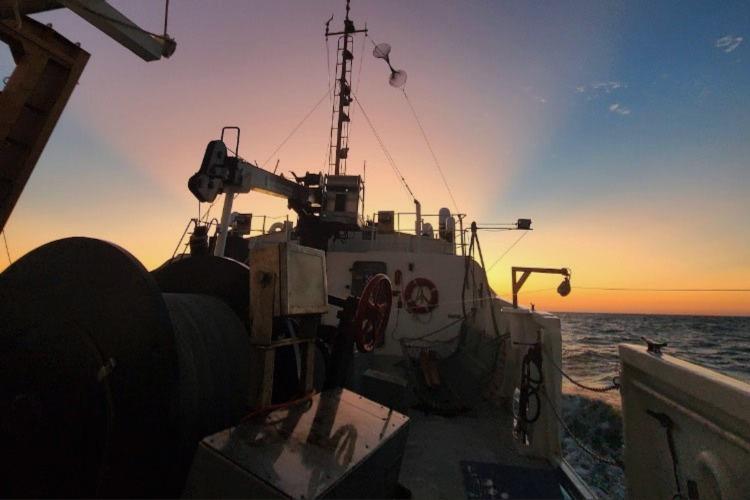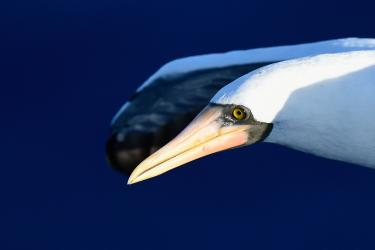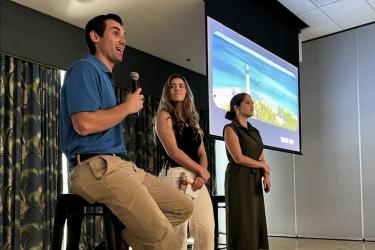Survey work conducted on NOAA research ships contributes important data to stock assessments and aids in long-term monitoring. Some surveys have been running for decades. The dedication and hard work by the crew and scientists have allowed us to learn about our ocean environments. For the dedicated few, life at sea becomes second nature and some spend months on end without the comforts of home or their family.
Hi, I’m Tralee Chapman, communications intern at the Southeast Fisheries Science Center. I spent 2 weeks aboard NOAA Ship Oregon II on the Southeast Bottom Longline Survey. I aided the science team on the night shift tagging sharks, taking measurements, and helping to collect samples. During that time I was able to interview some of my shipmates to get their perspectives on life at sea. Let's take a look at what it's like to live onboard a NOAA ship and a little bit about those who were on the recent voyage with Oregon II.
Adjusting in More Ways than One
There’s many aspects of life at sea that we take for granted here on land. First and foremost is the sturdy ground we walk on. When you’re living aboard a vessel, there’s nowhere to escape the motion of the ocean. This is why everything is secured into place at all times on a ship. Things like doors, cabinets, and drawers have latches or locking mechanisms, while chairs and furniture are made with sturdy, non-rolling bases. Also the weather can change in a moment out at sea so have your sea legs ready for a rocking ship.
Besides the movement, the next most noticeable difference is the tight spaces, shared facilities, and weaving layout. It can take a couple days to remember where everything is and how you get from one room to another. Also, things like watertight hatches, steep staircases, and new terms—such as galley (kitchen) and head (toilet)—add to the adjustment process. At sea most people share a room with at least one other person. Amenities such as showers, bathrooms, community areas, and the galley are shared among everyone. While sharing makes it hard to get quiet time to yourself, it also makes the ship environment a social one!
Work, Work, Work
While the living environment is much different than normal, the work on a ship keeps you busy and focused on the reason you’re out there in the first place! When you’re out at sea, the ship is running 24/7 which means there is work to be done at all hours. Different teams on the ship have different schedules. For example, our scientists and the deck crew work on 12-hour shifts that switch at noon and midnight. However, crew like the chief engineer or steward work normal day hours. Regardless, there’s always someone awake! On the ship side you have NOAA Commissioned Corps officers and professional mariners, including engineers, fishermen, electronic technicians, and more. They keep the ship running and ensuring the science team’s objectives are met in a timely and safe manner. On the science side, we’re working day and night collecting data, gathering samples, and setting up and retrieving gear.
Throughout this science being conducted, you may see scientists take a moment to snap a photo of an exceptionally large fish or shark they retrieved. While all of the sharks are tagged and returned to the water, reef fish like snapper and grouper are kept to provide key life history information. By sampling these fish we can gain critical information that informs stock assessments and ecosystem management. All the data collected also goes towards improving the sustainability of the commercial and recreational fisheries of these species. You can learn more about the usefulness of the data and samples we collect in our previous blogs.
People Make the World Go Round
I realize that at sea it really is the people and the harmony of them coming together that keeps everything running smoothly. On many NOAA ships, the crew consists of a wide diversity of people with backgrounds reaching all around the world. This was certainly the case aboard the Oregon II.
I found that getting to join everyone on Oregon II was exciting but also quite intimidating not knowing anyone. However, it was a great surprise to meet everyone and discover both how welcoming and how different we all were. I wanted to capture the diversity and different perspectives on board so I asked five questions to five people all serving different roles on the ship.
Listed in no particular order meet Walter, Arlene, Justin, Melissa, and Heather.
Walter Ingram
Where are you from?
I am from Jacksonville, Alabama.
What’s your role?
I’m a research fishery biologist at the Southeast Fisheries Science Center. My role is primarily to analyze data collected during the fishery-independent surveys we conduct. I provide this information to fishery stock assessment scientists and managers. I also participate in surveys such as this one.
How did you end up here?
After completing graduate school at the University of South Alabama/Dauphin Island Sea Laboratory, I immediately began work for the center, based in Pascagoula, Mississippi in 2001. Since then, I have been involved in fishery-independent research to support stock assessment.
What’s your favorite part? What keeps you coming back?
I love to be offshore. Most people will never get to see this part of nature. I also enjoy the camaraderie with my fellow scientists and crew.
If you could sum up life at sea in one word, what would it be?
Focused. The center survey scientists are very focused on the mission of collecting and providing the best fishery-independent data for use in stock assessments.
Arlene Beahm
Where are you from?
I am from Connecticut.
What’s your role?
I am the Second Cook, one of the professional mariners working on the ship.
How did you end up here?
After living in Italy for 20 years and my husband’s passing, I went to culinary school while raising my kids. From there I worked as a cook on a ship; however, my sister worked for NOAA and told me to apply. The rest is history!
What’s your favorite part? What keeps you coming back?
The isolation. I like to be alone and quiet. When we come into port and most people leave the ship then I have time to myself to read or watch the pelicans.
If you could sum up life at sea in one word, what would it be?
Freedom.
Justin Weeks
Where are you from?
I am from Roswell, Georgia.
What’s your role?
I am the ship’s Safety Officer and an Ensign in the NOAA Corps.
How did you end up here?
I heard about the opportunity in college while studying marine science. My mentor knew a captain in the NOAA Corps and offered to reach out and I pursued the opportunity from there.
What’s your favorite part? What keeps you coming back?
Getting to be in the field and helping facilitate science at sea is something I never got to do in college. The sunsets are great too.
If you could sum up life at sea in one word, what would it be?
Beautiful.
Melissa Trede
Where are you from?
I am from Fort Hood, Texas.
What’s your role?
I am the ship’s Operations Officer and a Lieutenant in the NOAA Corps.
How did you end up here?
I enlisted in the Navy and used my GI Bill to go to college. My goal was to stay in and become an officer and I decided to go to Texas A&M in Galveston. While I was there, I just happened to meet the NOAA Corps officer who worked at the Flower Garden Banks National Marine Sanctuary. I had never heard of NOAA Corps before. But, when I saw on their website “where science meets service,” I felt like it would be a great fit for me.
What’s your favorite part? What keeps you coming back?
The people. I am definitely a people person and I get to meet new and unique people all the time. But the crew on a ship becomes like family, and we have some great people here. They are what keep me going.
If you could sum up life at sea in one word, what would it be?
Swell.
Heather Moncrief-Cox
Where are you from?
I am originally from Panama City, Florida, where I spent most of my summers as a kid, but I grew up in Alabama.
What’s your role?
I join the surveys as a scientist to assist with data collection and biological sampling.
How did you end up here?
I have wanted to be a marine biologist my entire life, so earned my Bachelor’s of Science in Marine Biology. I then went on to earn a master’s of Science in Environmental Science from the University of West Florida in Pensacola, Florida. During graduate school, I became a fisheries observer for the Southeast Fisheries Science Center. I worked on commercial fishing vessels around the Gulf of Mexico and U.S. South Atlantic. I later became an assistant observer coordinator. This job took me off the boats, but allowed me work on shark life history studies based out of Panama City, Florida. When a position opened up in the Biology and Life History Branch, I jumped at the opportunity to work on life history full-time. I primarily study reproductive biology. I love what I do so much, I am now pursuing a doctorate in Fisheries and Aquatic Sciences at the University of Florida.
What’s your favorite part? What keeps you coming back?
I love being in the field and getting to be hands-on. My role now focuses on receiving the samples taken by the observers and surveys, followed by analyzing the data for stock assessments. Going out on the vessels allows me to be a part of the critical first steps in the process.
If you could sum up life at sea in one word, what would it be?
Adventurous.
Getting to interview my crewmates taught me so much about the diversity amongst everyone and opened my eyes to how important each person’s unique perspective is. There were two major things that stuck out to me. The first was how everyone’s path through life leading up to this point was totally different. They were all from different states, were different ages, different education levels, but they were all together on the Oregon II.
The other answer that stuck out to me was all the different words they used to describe life at sea. I even asked this question to others I didn’t interview and I never heard someone use the same word. Focused, freedom, beautiful, and dynamic are all such powerful and true words to describe life and work on a NOAA vessel. Each word also gives an insight into each person’s perspective and it’s this difference that leads to a well-balanced team.
By the way, my one word to sum up life at sea is: Enriching!
Meet the Blogger
Tralee Chapman











